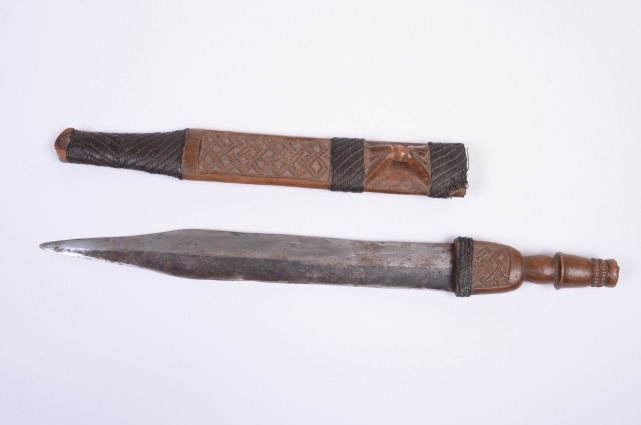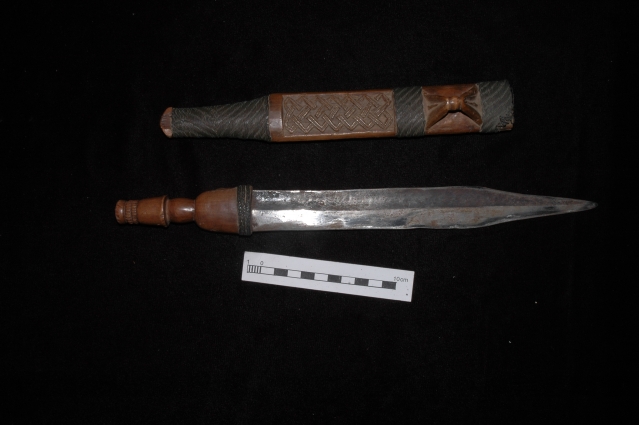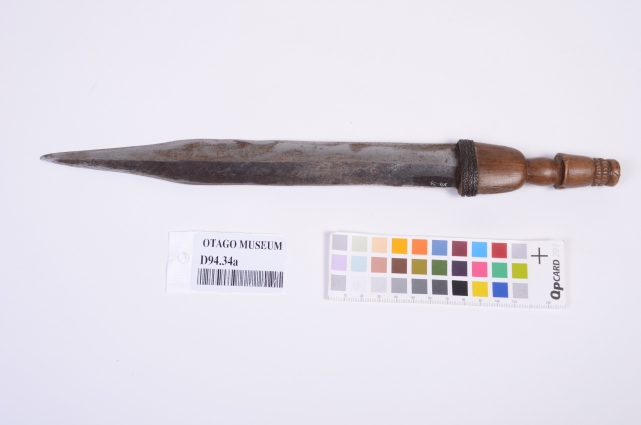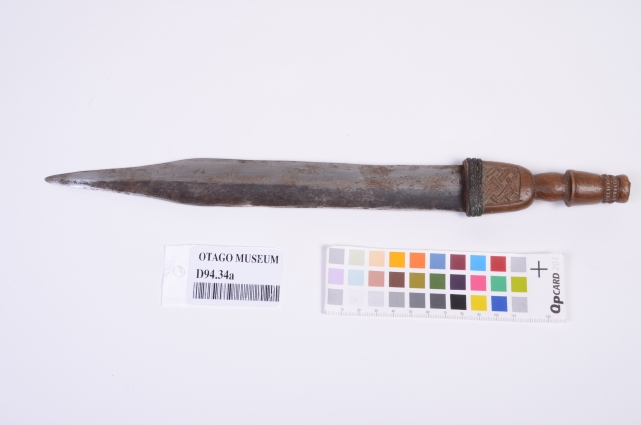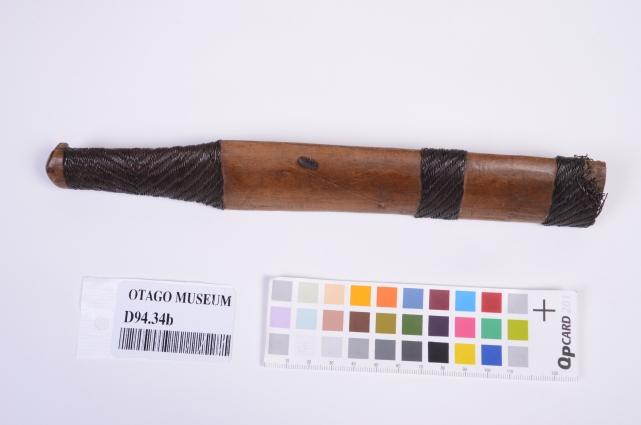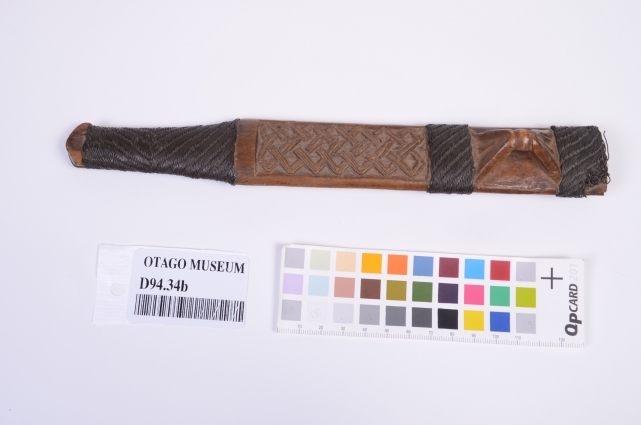Dagger, Sheath, D94.34
Physical Description
SHEATH is wood - two mirror image pieces tied back to back to form a common sheath. Each piece of wood has been shaved on one side forming a concave surface the length of the sheath. These concave surfaces are facing each other when the two pieces are tied together - forming a channel for the blade. The outside of one side of the sheath has been carved with an interlocking symmetrical weave extending the width of the sheath and covering the middle third of the sheath. Near the top of the sheath the wood extends out in a somewhat pyramidal shape with a hollow underneath, giving the appearance of being an appendage through which a small belt might be strung. Thus providing an attachment point for someone carrying it. Thus hollow shows no apparent excess wear, i.e. gives no appearance of having been attached to a belt, i.e. no excess wear marks or patina. The upper 2/3s of the sheath have parallel sides, i.e. the same width from top to 2/3 down. The bottom third is tapered to a somewhat rounded point. The top 23 mm is wrapped with a skilful and intricate weaving of fine copper(?) wire (roughly 1/2mm diam. wire). Immediately above the middle third carving is another wrapping of wire of near identical weave and width, i.e. a weaving completely wrapping the sheath and approx. 20mm wide. The bottom third of the sheath is likewise of the same wire weave enclosing the tapering end and extending to just above the pointed tip of the sheath. The three sets of wire weavings appear to be the means of holding together the two sides of the sheath. The side of the sheath opposite the carved side is plain, i.e. smooth with no carving.
KNIFE is a double sided hand(?) smithed iron blade. With essentially parallel edges, the bottom 80mm tapers to a point. The blade extends up and apparently through the full length of the wooden handle. The iron extension narrows considerably through the handle to exit at the top end of the handle as a narrow slightly bent tang, presumably to securely fasten the handle. The blade has a blood grove or hollow one half the width of the blade extending from the right side of the handle down the full length of the blade to the tapered point. When the blade is rotated 180 degrees, the blood grove is duplicated on the right side. The wooden handle - approx. 100mm long - receives the blade as a flat piece of wood but gradually narrows to a round waist at the middle. This flares to a slightly larger (diameter) with a gradual tapering to the top end. Near the top 2 narrow rows of small squares are carved the full circumference of the handle, topped by a narrow cap with slight diagonal cuts again running the full circumference. The wooden handle appears to be one piece of wood. One side of the handle at the bottom flat portion has the near identical pattern to that of the sheath of the interlocking symmetrical weaved carved into it. The extreme bottom of the wooden handle immediately above the blade/handle interface has three narrow, parallel, tightly woven/braided strips of the same copper wire wrapped the full circumference of the handle. Apart from being decorative this likely maintains the integrity of the wooden handle, preventing it from splitting by any pressure applied from the blade. The General appearance of both knife and sheath is that of being used, i.e. a general patina of wear is apparent. Both knife and handle are in good condition, with but a bit of the wire weaving unwrapped on the top end of the sheath.
KNIFE is a double sided hand(?) smithed iron blade. With essentially parallel edges, the bottom 80mm tapers to a point. The blade extends up and apparently through the full length of the wooden handle. The iron extension narrows considerably through the handle to exit at the top end of the handle as a narrow slightly bent tang, presumably to securely fasten the handle. The blade has a blood grove or hollow one half the width of the blade extending from the right side of the handle down the full length of the blade to the tapered point. When the blade is rotated 180 degrees, the blood grove is duplicated on the right side. The wooden handle - approx. 100mm long - receives the blade as a flat piece of wood but gradually narrows to a round waist at the middle. This flares to a slightly larger (diameter) with a gradual tapering to the top end. Near the top 2 narrow rows of small squares are carved the full circumference of the handle, topped by a narrow cap with slight diagonal cuts again running the full circumference. The wooden handle appears to be one piece of wood. One side of the handle at the bottom flat portion has the near identical pattern to that of the sheath of the interlocking symmetrical weaved carved into it. The extreme bottom of the wooden handle immediately above the blade/handle interface has three narrow, parallel, tightly woven/braided strips of the same copper wire wrapped the full circumference of the handle. Apart from being decorative this likely maintains the integrity of the wooden handle, preventing it from splitting by any pressure applied from the blade. The General appearance of both knife and sheath is that of being used, i.e. a general patina of wear is apparent. Both knife and handle are in good condition, with but a bit of the wire weaving unwrapped on the top end of the sheath.
Research Notes
Likely SHONA of Zimbabwe http://webprojects.prm.ox.ac.uk/arms-and-armour/o/africa/1905.45.1/ Likely Zimbabwe SHEATH= Wood & fine wire (copper?). KNIFE=Iron (hand forged?), wood, & fine wire (copper?) "Quoting from : http://webprojects.prm.ox.ac.uk/arms-and-armour/o/africa/1905.45.1/
Pitt Rivers Museum
Information
""The bakatwa is a double-edged sword of the Shona people of Zimbabwe, used in religious ceremonies. This example dates to the 19th century. It has a distinctive blade, one half being recessed and painted a dark colour, a carved ebony scabbard and a hilt plaited and bound in brass wire.
Sacred Weapons
In historical times, all Shona men carried a knife or sword of some kind, for use in self-defence and hunting. The ceremonial bakatwa can be distinguished from everyday Shona blades (known as banga) because of its double-edged form and the intricate woven brass wire decoration on the hilt. This weapon was accorded a high level of prestige in traditional Shona religious practice.
Bakatwa were and are passed down from generation to generation in a lineage, and were used in religious rituals to symbolise the presence of the owner’s ancestors, the sword’s previous owners. In these rituals, the owner addressed the bakatwa as if it was the physical embodiment of his ancestors. This link between the spirits and these swords also meant that n’angas (diviner-healers) and svikiros (spirit-mediums) carried them as the insignia of their profession. Certain Shona hunters were traditionally believed to be under the spiritual influence and guidance of deceased hunters, known as shave spirits, so they also carried bakatwa as a symbol of their spirit ally.
The traditional carrying of plainer, more functional swords as everyday weapons dwindled under the influence of Christian missionaries. The Government also launched drives to prevent men travelling armed during the civil unrest of the 1970s. This meant that knives and swords were largely restricted to ceremonial use. However, bakatwa have enjoyed something of a renaissance in recent years, as symbols of traditional cultural identity and Zimbabwean independence from British imperialism. Some recent examples of bakatwa have even been forged to resemble AK-47 machine-guns, with the blade sheathed inside the gun’s barrel.""
SHEATH is wood - two mirror image pieces tied back to back to form a common sheath. Each piece of wood has been shaved on one side forming a concave surface the length of the sheath. These concave surfaces are facing each other when the two pieces are tied together - forming a channel for the blade. The outside of one side of the sheath has been carved with an interlocking symmetrical weave extending the width of the sheath and covering the middle third of the sheath. Near the top of the sheath the wood extends out in a somewhat pyramidal shape with a hollow underneath, giving the appearance of being an appendage through which a small belt might be strung. Thus providing an attachment point for someone carrying it. Thus hollow shows no apparent excess wear, i.e. gives no appearance of having been attached to a belt, i.e. no excess wear marks or patina. The upper 2/3s of the sheath have parallel sides, i.e. the same width from top to 2/3 down. The bottom third is tapered to a somewhat rounded point. The top 23 mm is wrapped with a skilful and intricate weaving of fine copper(?) wire (roughly 1/2mm diam. wire). Immediately above the middle third carving is another wrapping of wire of near identical weave and width, i.e. a weaving completely wrapping the sheath and approx. 20mm wide. The bottom third of the sheath is likewise of the same wire weave enclosing the tapering end and extending to just above the pointed tip of the sheath. The three sets of wire weavings appear to be the means of holding together the two sides of the sheath. The side of the sheath opposite the carved side is plain, i.e. smooth with no carving.
KNIFE is a double sided hand(?) smithed iron blade. With essentially parallel edges, the bottom 80mm tapers to a point. The blade extends up and apparently through the full length of the wooden handle. The iron extension narrows considerably through the handle to exit at the top end of the handle as a narrow slightly bent tang, presumably to securely fasten the handle. The blade has a blood grove or hollow one half the width of the blade extending from the right side of the handle down the full length of the blade to the tapered point. When the blade is rotated 180 degrees, the blood grove is duplicated on the right side. The wooden handle - approx. 100mm long - receives the blade as a flat piece of wood but gradually narrows to a round waist at the middle. This flares to a slightly larger (diameter) with a gradual tapering to the top end. Near the top 2 narrow rows of small squares are carved the full circumference of the handle, topped by a narrow cap with slight diagonal cuts again running the full circumference. The wooden handle appears to be one piece of wood. One side of the handle at the bottom flat portion has the near identical pattern to that of the sheath of the interlocking symmetrical weaved carved into it. The extreme bottom of the wooden handle immediately above the blade/handle interface has three narrow, parallel, tightly woven/braided strips of the same copper wire wrapped the full circumference of the handle. Apart from being decorative this likely maintains the integrity of the wooden handle, preventing it from splitting by any pressure applied from the blade. The General appearance of both knife and sheath is that of being used, i.e. a general patina of wear is apparent. Both knife and handle are in good condition, with but a bit of the wire weaving unwrapped on the top end of the sheath.
SHEATH length = 253mm. Width at top/widest point = 38mm. Thickness of sheath = approx. 10mm.
KNIFE length = 355mm. Blade = 254mm. Handle = 101mm. Likely in Shona language is "BAKATWA"
Pitt Rivers Museum
Information
""The bakatwa is a double-edged sword of the Shona people of Zimbabwe, used in religious ceremonies. This example dates to the 19th century. It has a distinctive blade, one half being recessed and painted a dark colour, a carved ebony scabbard and a hilt plaited and bound in brass wire.
Sacred Weapons
In historical times, all Shona men carried a knife or sword of some kind, for use in self-defence and hunting. The ceremonial bakatwa can be distinguished from everyday Shona blades (known as banga) because of its double-edged form and the intricate woven brass wire decoration on the hilt. This weapon was accorded a high level of prestige in traditional Shona religious practice.
Bakatwa were and are passed down from generation to generation in a lineage, and were used in religious rituals to symbolise the presence of the owner’s ancestors, the sword’s previous owners. In these rituals, the owner addressed the bakatwa as if it was the physical embodiment of his ancestors. This link between the spirits and these swords also meant that n’angas (diviner-healers) and svikiros (spirit-mediums) carried them as the insignia of their profession. Certain Shona hunters were traditionally believed to be under the spiritual influence and guidance of deceased hunters, known as shave spirits, so they also carried bakatwa as a symbol of their spirit ally.
The traditional carrying of plainer, more functional swords as everyday weapons dwindled under the influence of Christian missionaries. The Government also launched drives to prevent men travelling armed during the civil unrest of the 1970s. This meant that knives and swords were largely restricted to ceremonial use. However, bakatwa have enjoyed something of a renaissance in recent years, as symbols of traditional cultural identity and Zimbabwean independence from British imperialism. Some recent examples of bakatwa have even been forged to resemble AK-47 machine-guns, with the blade sheathed inside the gun’s barrel.""
SHEATH is wood - two mirror image pieces tied back to back to form a common sheath. Each piece of wood has been shaved on one side forming a concave surface the length of the sheath. These concave surfaces are facing each other when the two pieces are tied together - forming a channel for the blade. The outside of one side of the sheath has been carved with an interlocking symmetrical weave extending the width of the sheath and covering the middle third of the sheath. Near the top of the sheath the wood extends out in a somewhat pyramidal shape with a hollow underneath, giving the appearance of being an appendage through which a small belt might be strung. Thus providing an attachment point for someone carrying it. Thus hollow shows no apparent excess wear, i.e. gives no appearance of having been attached to a belt, i.e. no excess wear marks or patina. The upper 2/3s of the sheath have parallel sides, i.e. the same width from top to 2/3 down. The bottom third is tapered to a somewhat rounded point. The top 23 mm is wrapped with a skilful and intricate weaving of fine copper(?) wire (roughly 1/2mm diam. wire). Immediately above the middle third carving is another wrapping of wire of near identical weave and width, i.e. a weaving completely wrapping the sheath and approx. 20mm wide. The bottom third of the sheath is likewise of the same wire weave enclosing the tapering end and extending to just above the pointed tip of the sheath. The three sets of wire weavings appear to be the means of holding together the two sides of the sheath. The side of the sheath opposite the carved side is plain, i.e. smooth with no carving.
KNIFE is a double sided hand(?) smithed iron blade. With essentially parallel edges, the bottom 80mm tapers to a point. The blade extends up and apparently through the full length of the wooden handle. The iron extension narrows considerably through the handle to exit at the top end of the handle as a narrow slightly bent tang, presumably to securely fasten the handle. The blade has a blood grove or hollow one half the width of the blade extending from the right side of the handle down the full length of the blade to the tapered point. When the blade is rotated 180 degrees, the blood grove is duplicated on the right side. The wooden handle - approx. 100mm long - receives the blade as a flat piece of wood but gradually narrows to a round waist at the middle. This flares to a slightly larger (diameter) with a gradual tapering to the top end. Near the top 2 narrow rows of small squares are carved the full circumference of the handle, topped by a narrow cap with slight diagonal cuts again running the full circumference. The wooden handle appears to be one piece of wood. One side of the handle at the bottom flat portion has the near identical pattern to that of the sheath of the interlocking symmetrical weaved carved into it. The extreme bottom of the wooden handle immediately above the blade/handle interface has three narrow, parallel, tightly woven/braided strips of the same copper wire wrapped the full circumference of the handle. Apart from being decorative this likely maintains the integrity of the wooden handle, preventing it from splitting by any pressure applied from the blade. The General appearance of both knife and sheath is that of being used, i.e. a general patina of wear is apparent. Both knife and handle are in good condition, with but a bit of the wire weaving unwrapped on the top end of the sheath.
SHEATH length = 253mm. Width at top/widest point = 38mm. Thickness of sheath = approx. 10mm.
KNIFE length = 355mm. Blade = 254mm. Handle = 101mm. Likely in Shona language is "BAKATWA"
Provenance
Locality:
Africa
Locality according to: Joel A Vanderburg
Zimbabwe
Measurements
Maximum dimensions (H x W x D) (a - Dagger): 355 x 37 x 22mmMaximum dimensions (H x W x D) (b - Sheath): 255 x 38 x 31mm
All Rights Reserved

